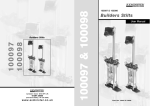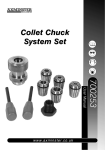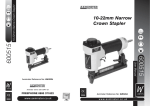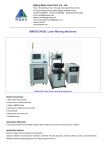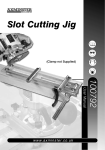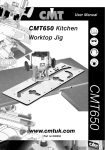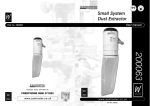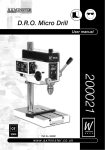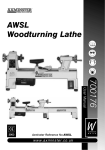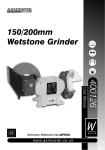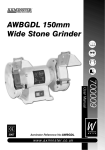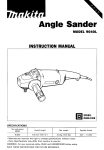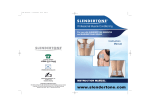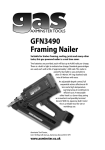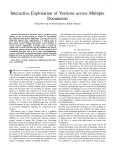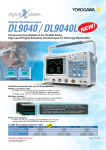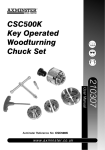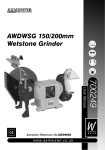Download W - Axminster Power Tool Centre
Transcript
200433 16-40mm Air Stapler User Manual 200433 16-40mm Air Stapler Axminster Reference No: AW9040L W AXMINSTER W H I T E Axminster Devon EX13 5PH UK FREEPHONE 0800 371822 2001 www.axminster.co.uk 2001 Axminster Reference No: AW9040L w w w. a x m i n s t e r. c o . u k W AXMINSTER W H I T E Parts List... Index of Contents... W AXMINSTER W H I T E Page No. Index of Contents.................................................................................................................... 02 Declaration of Conformity………….………........……..………….........................................03 What’s in the Box………….………........……..…………...........................................................04 General safety Precautions for the Stapler.........................................................04-05 Initial Assembly.........................................................................................................06 Specifications….………........……..………….........................................................................06 Identification and Description................................................................................................ 07 Illustration and Parts Description................................................................................. 08-09-10 Setup....................................................................................................................................... 11 Operating Instructions............................................................................................................ 11 Troubleshooting.......................................................................................................................12 Routine Maintenance.............................................................................................................. 13 Parts Breakdown......................................................................................................................14 Parts List...................................................................................................................................15 y Helm fet sp irator Re Sa Two E R Ey fety Viso Sa et st Mask Du F ootw ety r Def ende rs n ar s ve ro tectio eP tiv e Glo tec r ea n Asse Ma bly m al d Manu ea Saf The symbols shown on the cover of this manual advise that you wear the correct safety protection when using this machine. SAFETY!! Pro ! Safety Protection Symbols W AXMINSTER W H I T E FREEPHONE 0800 371822 15 W Declaration of Conformity... Parts Breakdown... W AXMINSTER W H I T E AXMINSTER W H I T E Copied from CE Certificate The undersigned, O. Schiller authorised by Chongqing Hongyuan Pneumatic Tool Factory No. 107, Jienan Street, Banan District Chongqing, CHINA declares that this product: Air Nailer 9040L manufactured by Chongqing Hongyuan Pneumatic Tool Factory is in compliance with the following standards or standardisation documents in accordance with Council Directives 98/37/EG / 98/37/EC 14 www.axminster.co.uk FREEPHONE 0800 371822 03 W What’s in the Box... Routine Maintenance... AXMINSTER W H I T E Model Number: 9040L 1 No. 16-40mm Stapler 1 No. 3mm Allen Key 1 No. 4mm Allen Key 1 No. Bottle Air Tool Oil 1 No. Manual 1 No. Carry Case Having unpacked your AW9040L, please check the contents against the ‘What’s in the box’ list above. If there are any pieces missing or damaged, contact our sales and servicing department in accordance with the instructions laid down in our catalogue. Please dispose of any unwanted packaging responsibly. A lot of the packaging is bio-degradable. Frequent, but not excessive, lubrication is required for best performance. Oil added through the airline connection will lubricate internal parts. An automatic airline oiler is recommended but oil may be added manually before every operation or after about I hour of continuous use. W AXMINSTER W H I T E Only a few drops of oil at a time are necessary. Too much oil will collect inside the tool and will be blown out during the exhaust cycle. ONLY USE PNEUMATIC TOOL OIL. Do not use detergent oil or additives, as these lubricants win cause accelerated wear to the seals in the tool. Use a small amount of ordinary light machine oil on all moving surfaces and pivots. Dirt and water in the air supply are major causes of pneumatic tool wear. Use a filter/oiler for better performance and longer life. The filter must have adequate flow capacity for the specific application. Consult the manufacturer's instructions for proper maintenance of your filter. Keep tools clean for better and safer performance. Use nonflammable cleaning solutions only if necessary (CAUTION: Such solutions may damage O-rings and other tool parts) - DO NOT SOAK. Connector General Safety Precautions for the Stapler... Few drops of oil Fig 6 Good Working Practices/Safety The following suggestions will enable you to observe good working practices, keep yourself and fellow workers safe and maintain your tools and equipment in good working order. ! WARNING!! KEEP TOOLS AND EQUIPMENT OUT OF THE REACH OF YOUNG CHILDREN 1. KEEP WORK AREA CLEAN... Cluttered areas invite injuries. 2. KEEP CHILDREN AWAY. All children should be kept away from the work area. Don't let them handle the tool. 3.PRESCRIPTION MEDICATION. Read the warning labels on all medicines to determine if your judgment or reflexes would be impaired. If there is any doubt, do not attempt to operate this tool. 4. USE EYE PROTECTION. Eye protection should conform to BSI specifications and provide protection against flying debris from the front and the side. Eye protection should be worn when loading, unloading, servicing or operating this tool. Fig 6a OIL 5. USE EAR DEFENDERS. Repetitive high noise levels can damage hearing. If the work area in which you are operating has excessively high noise levels, wear ear protection. 04 6. NEVER USE OXYGEN, COMBUSTIBLE GASES, BOTTLED GASES OR HIGH PRESSURE COMPRESSED GAS AS A POWER SOURCE FOR THIS TOOL. The tool may explode and cause serious injury. Light oil 13 W AXMINSTER W H I T E Troubleshooting... STOP USING THE TOOL IMMEDIATELY IF ANY OF THE FOLLOWING PROBLEMS OCCUR. SERIOUS PERSONAL INJURY COULD OCCUR. ANY REPAIRS OR REPLACEMENTS MUST BE DONE BY A QUALIFIED OR AN AUTHORISED SERVICE CENTRE ONLY. PROBLEM PROBLEM CAUSE 7. WEAR APPROPRIATE CLOTHING. Protective gloves and non-skid footwear/safety shoes are recommended when operating this tool. Don't wear loose clothing or jewellry. They can get caught in moving parts. If you wear your hair in a long style, a safety helmet, hat, protective hair covering or even a sweatband will help to minimise the chance of hair being caught up in the tool. SOLUTION 8. DO NOT FIRE INTO HARD MATERIALS. This tool was designed to fire fasteners into wood or like materials, DO NOT attempt to fire fasteners into hard or brittle materials, such as concrete, ceramics, tiling or steel. 1.Check and replace O-ring. 2.Check and replace trigger valve head. 3.Check and replace trigger valve stem, seal or O-ring. Air leaking between body and front plate Damaged piston O-ring or bumper. Check and replace O-ring or bumper. Air leaking between body and cylinder cap. 1.Screw loose. 2.Damaged seal. 1.Tighten screws. 2.Check and replace seal. 10. CHECK THE TOOL FOR DAMAGE. Before using the tool, check for damage, any part that seems damaged should be carefully checked to determine that it operates properly and will perform its intended function. If there is any doubt, have the tool repaired and tested by a suitably qualified person. 1.Worn bumper. 2.Air pressure is too high. 1.Replace bumper. 2.Adjust the air pressure. 11. REPLACEMENT PARTS AND ACCESSORIES. When servicing, only use approved replacement parts. Only fit the approved accessories intended for use with this tool. 1.Insufficient oil. 2.Insufficient air supply. 3.Broken spring in cylinder cap. 4.Exhaust port in cylinder cap is blocked. 1.Lubricate as instructed. 2.Check air supply. 3.Replace spring. 4.Replace damaged internal parts. 1.Worn bumper or damaged spring (62). 2.Dirt in front plate. 3.Inadequate airflow to tool. 4.Worn or dry O-ring on piston. 5.Damaged O-ring on trigger valve. 6.Cylinder cap seal leaking. 1.Replace bumper or spring. 1.Joint guider is worn. 2.Fasteners are wrong size or damaged. 3.Magazine or front plate screws are loose. 4.Blade in piston assembly is damaged. 1.Replace joint guider. 2.Use the recommended and undamaged fasteners. 3.Tighten screws. 1.Worn blade in piston assembly. 2.Lack of power. 3.Slow cycling and loss of power. 1.Replace piston assembly. 2.Adjust to adequate air pressure. 3.Check cylinder cap spring for broken coils or reduced length. Check if exhaust port of cylinder cap is restricted. Blade driving fastener too deeply Runs slowly or has power loss Tool skips a fastener Fasteners are jammed Tool will not drive down tight W AXMINSTER W H I T E 1.O-ring in trigger valve is damaged. 2.Trigger valve head is damaged. 3.Trigger valve stem, seal or O-ring are damaged. Air leaking at trigger area 12 General Safety Precautions for the Stapler... 2.Clean drive channel of front plate. 3.Check hose and compressor fittings. 4.Replace O-ring or lubricate. 5.Replace O-ring. 6.Replace seal. 4.Replace piston assembly 9. DO NOT OVERREACH. Keep proper footing and balance at all times, do not perform simian acrobatic feats to get that little bit longer reach, especially when working from ladders or towers, the extra time required to reposition the tower or ladder is a good trade off against a potentially crippling fall. 12. STAY ALERT. Watch what you are doing. Use common sense, do not operate any tool if you are tired or subject to distraction, a fastener fired into any part of your anatomy is not a recommended experience. 13. STORE IDLE EQUIPMENT. When not in use, the tool should be cleaned, unloaded, lightly oiled, stowed away in its Carry Case, and stored away in a dry location to prevent the possibility of rusting. The storage position should be out of reach of children. 14. USING OUTDOORS. If the tool and its attendant air compressor are to be used outdoors, carry out the general safety checks concerned with operating 230V machines, specifically check plugs, power leads, extension cables and the power supply. Do not operate exposed 230V mains supplied machines in wet weather conditions and do not trail extension leads across wet or puddled sites. I5. AIR LINES AND THEIR CONNECTIONS. Be aware of the position and ‘lay’ of your air lines. During the setting up procedures for the job, check that the lines will not ‘snag’ during the expected tool travel. (Curly’s are the worst, aren’t they?). Check all air line connections, ensure there are no leaks. 16. BE AWARE OF OTHER PEOPLE. Never point the tool at people or animals, even in jest. 17. USE THE CORRECT AIR CONNECTOR. The connector on the tool must not be a non return type. It must not hold pressure in the gun if the air line is disconnected. If the wrong fitting is used the tool could remain charged and still have the ability to drive a fastener whilst in an apparent ‘safe’ condition. WARNING: The warnings, cautions and instructions discussed in this instruction manual cannot cover all possible conditions and situations that may occur. It must be understood by the operator that COMMON SENSE AND CAUTION ARE FACTORS WHICH CANNOT BE BUILT INTO THIS TOOL. THEY MUST BE SUPPLIED BY THE OPERATOR. 05 W Initial Assembly... Setup... AXMINSTER W H I T E W AXMINSTER W H I T E Your air tool is fully assembled when you receive it. All that requires to be done, is for you to select the method whereby you wish to connect the gun to the air supply system. Assemble the chosen connector into the 1/4" BSP port in the rear of the handle. If this is the first time that the gun is being used, introduce a liberal ‘squirt’ of the supplied oil into the connector. See fig 6. (even if your air supply system has an in line automatic oiler). Be sure the air line is depressurized when installing or removing adaptors. See fig 5 below for a recommended connection order for the air supply system. Fig 5 Tap Quick connector Oiler Filter ‘T’ Piece Specification... Axminster No. Minimum Operating Air Pressure Maximum Operating Air Pressure 100 PSI 16-40mm Staple Size 18 Gauge Air Inlet 100 1/4"BSP Air Consumption Tool Weight 1.7 CFM at 80PSI 1.5kg Regulator Air Supply Stapler 60 PSI Staple Length Range Staple Capacity Air hose 200433 (AW9040L) Operating Instructions... Turn the compressor on and set the regulator to the proper pressure for the size and type of fastener being used. ! Make sure the Air nailer is DISCONNECTED from the air supply when loading the fasteners. Depress the magazine slide latch to release the MAGAZINE SLIDE and pull the magazine slide out fully as shown in Figure 3. Place a full clip of the required type and size of fastener onto the MAGAZINE TRAY, (up to 100 fasteners may be loaded in the magazine). Push the MAGAZINE SLIDE ASSEMBLY forward until it locks. Connect the tool to the air supply; your air stapler is now ready for use. Hold the tool by its handle (DO NOT put your finger in the trigger vicinity yet), place the mouth of the gun where you wish to fire the fastener, press the gun down to the work surface to activate the “permit” safety. Make sure the gun is straight and upright, now move your finger to the trigger and fire the fastener home. Be prepared for a certain amount of recoil, especially if driving into very hard timber. Make sure you control the recoil or you could initiate ‘bounce stapling’. This happens if the recoil causes the gun to bounce clear of the work surface. If it bounces high enough to enable the “permit” safety to reset, as the gun comes back down to the work surface, if the trigger is still pressed, another staple is fired. This situation can be further exacerbated, if the second staple strikes the head of the first,….. even greater recoil…………..I leave it to your imagination. Although this situation can be both annoying and even comical in some aspects, it can constitute a real hazard, as the gun is effectively ‘out of control’. It can also cause damage to the “striker”, especially if the gun jams because the staple could not be fired properly. Learn to control recoil. When the staple has been fired, lift the tool off the work surface. 06 www.axminster.co.uk Note. It is always a good policy to test the driven depth in a sample piece of wood before commencing the job ‘proper’. If the fasteners are being driven too far or not far enough, adjust the regulator (see fig 2a) to provide less or more air pressure, as required. There is a pictogram above the regulator which shows the direction to turn the regulator in order to drive the fasteners deeper or less deep. (See fig 2b). 11 W Illustration and Parts Description... Identification and Description... AXMINSTER W H I T E W AXMINSTER W H I T E Fig 3 Magazine slide latch Main body (See fig 1) The main body is a casting that is extruded into the handle, the cylinder housing, and the mounting points for the magazine assembly. It has a ‘soft grip’ sleeve moulded over the handle portion. Connection port This is a 1/4” BSP threaded hole which will allow you to mount the (See fig 2) connector of choice, to allow connection to the air supply. Magazine slide latch A sprung loaded thumb latch that locks the magazine slide closed. It is depressed to unlock the magazine slide to allow it to be withdrawn, to facilitate the loading and unloading of the magazine. (See figs 1& 3) Magazine assembly (See fig 1) The magazine assembly is mounted on the staple guide body and supported at the rear underside of the handle. The magazine basically consists of a saddle bar over which the staples are seated, the magazine slide plate covers the staples. Part of the slide plate mechanism is a sprung shoe that pushes the staples along the saddle bar and forces them into the receiver in the staple guide body. (See fig 4b) “Permit” safety (See fig 1a) This is a safety device that will only permit the Staples to be fired if the mouth of the Stapler is in contact with the work surface. It is a metal pressing that is around and extends below the mouth of the stapler. It is sprung biased to the down position. When the gun is pressed down against the work surface the permit safety is pushed up. A lever (part of the pressing) arms the trigger so that the gun can be fired. Trigger (See fig 2) Provided it has been armed by the “permit” safety, pressing the trigger will allow the gun to fire the staple into the material. Air pulse divertor (See fig 2) A moulded plastic cover on the top of the main body. It allows the spent air to be exhausted through the top of the cylinder housing. It can be swivelled through 360 degrees to direct the air pulse away from the face? hand? workpiece??? et.al. Quick unjam release (See fig 4a) Should the stapler suffer a jam, this quick release toggle provides a very fast and easy way to clear it. Flipping the lever forward releases the front plate, allowing access to the staple channel and the receiver slot in the guide body. Magazine tray Fig 4 Staple channel and receiver slot Fig 4b Quick unjam release Fig 4a 10 FREEPHONE 0800 371822 07 W Illustration and Parts Description... Illustration and Parts Description... AXMINSTER W H I T E W AXMINSTER W H I T E Air pulse divertor Fig 1 Fig 2 Main body Connection port Trigger Trigger Quick unjam release Fig 2a More air pressure Magazine slide latch Less air pressure Magazine assembly Fig 2b Driven depth pictogram Fig 1a 08 Permit safety www.axminster.co.uk Driven depth regulator FREEPHONE 0800 371822 09








